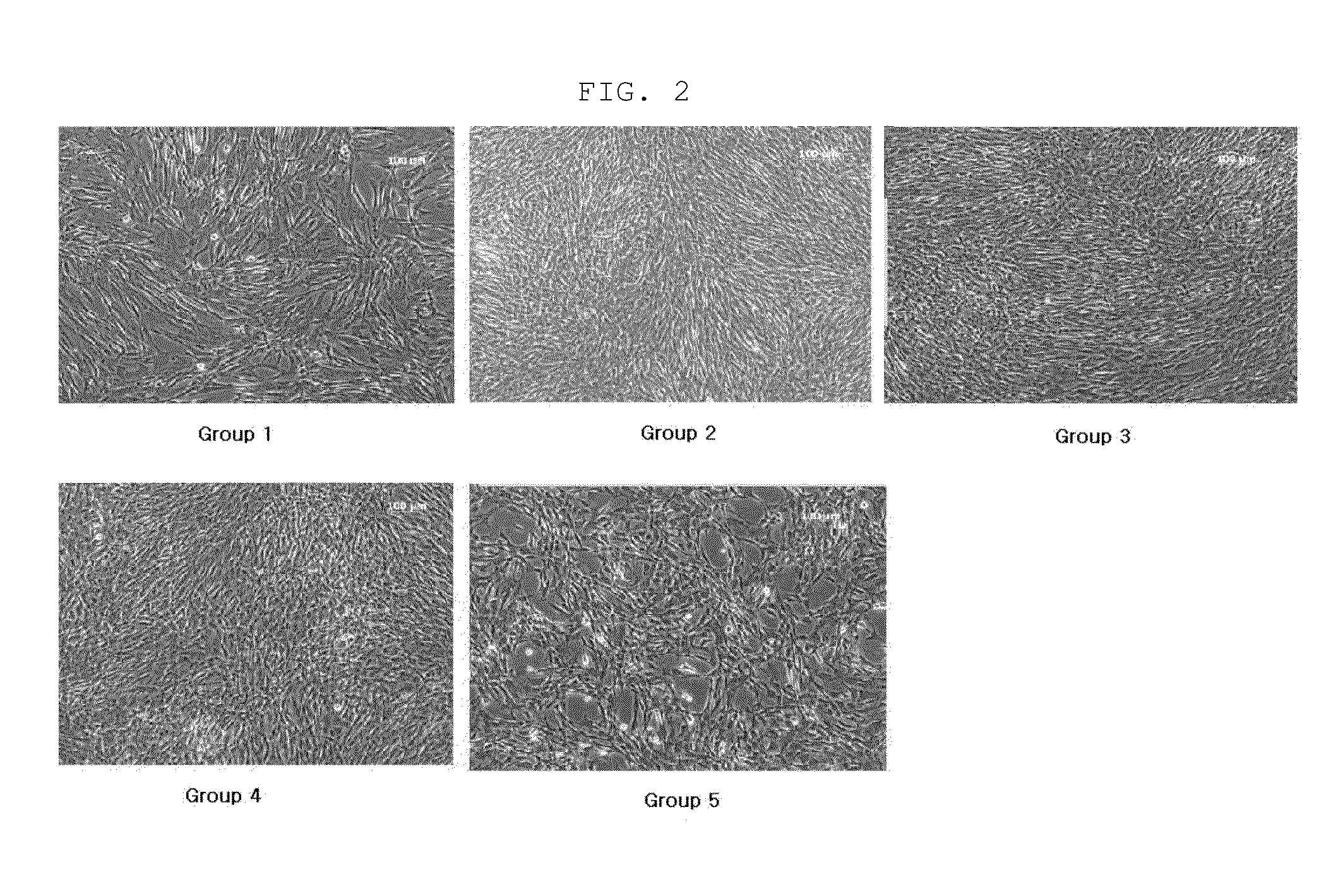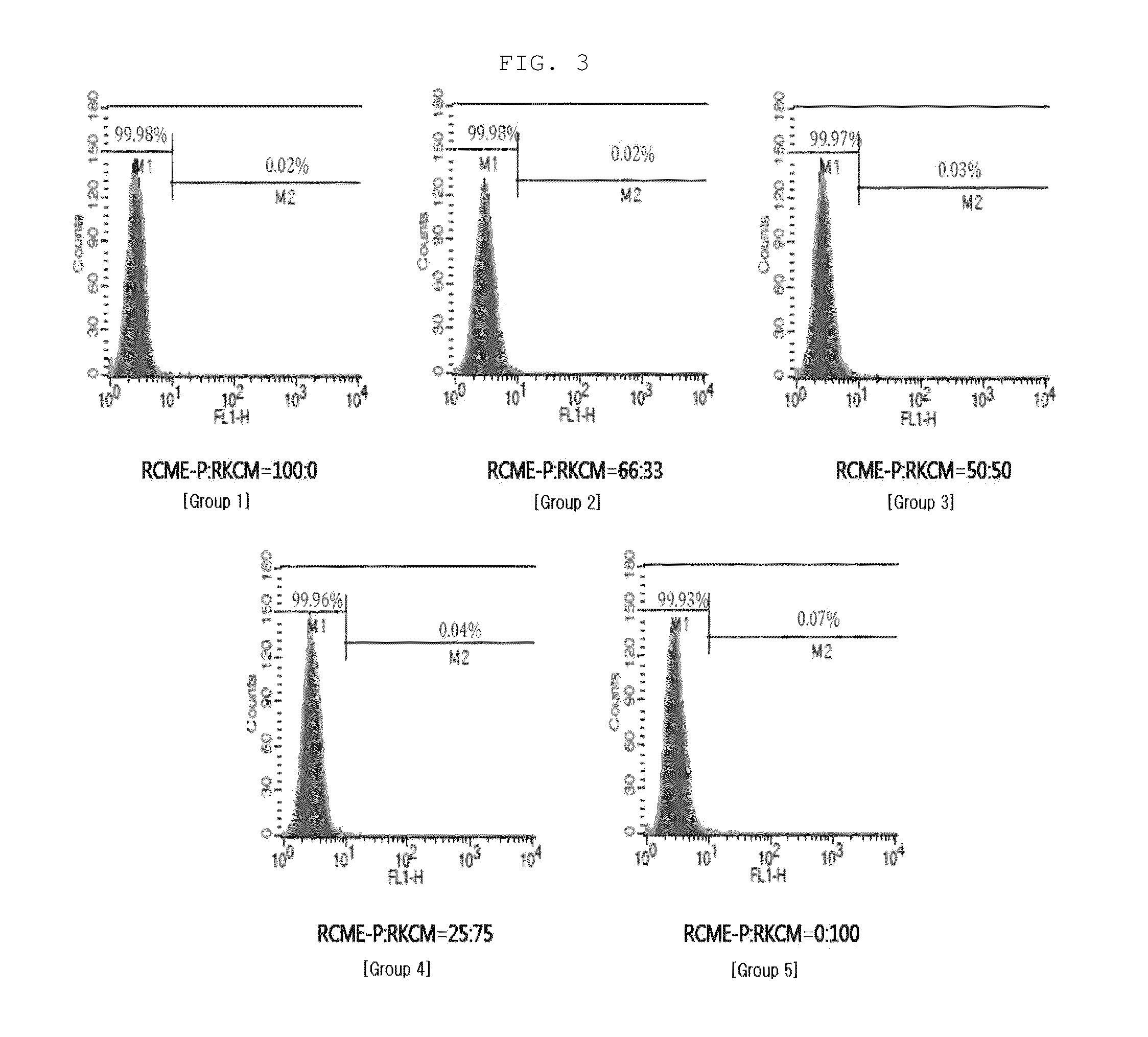Culture medium composition for culturing amnion-derived mesenchymal stem cell, and method for culturing amnion-derived mesenchymal stem cell by using same
a mesenchymal stem cell and medium composition technology, applied in the field of medium for culturing mesenchymal stem cells, can solve the problems of difficult culture, limited use of fetal tissue as the source of cell therapeutic agents, and difficult to maintain isolated stem cells in vitro, so as to maintain the ability of cells to differentiate and cell proliferation rate high
- Summary
- Abstract
- Description
- Claims
- Application Information
AI Technical Summary
Benefits of technology
Problems solved by technology
Method used
Image
Examples
example 1
Isolation of Mesenchymal Stem Cells from Amnion Tissue
[0037]Amnion tissue used in the example of the present invention was isolated from the placenta, and the isolated tissue was placed in an antibiotic-containing saline or DMEM (Dulbecco modified Eagle medium) medium and then transferred to the laboratory.
[0038]In a clean bench, 5 g of amnion tissue was washed with sterile saline, and in a Petri dish, the washed amnion tissue was cut as finely as possible with surgical scissors. A collagenase solution was added to and mixed well with the finely cut tissue. The mixture was placed in a flask which was then incubated in a 5% CO2 incubator at 37° C. for 90 minutes to lyse the tissue. The lysed tissue was filtered through a cell strainer in a 50 mL tube and centrifuged. After centrifugation, the supernatant was removed, and the cell precipitate was suspended in DMEM-P and inoculated into a T-flask, which was then incubated in a 5% CO2 incubator at 37° C. for 3-4 days. Then, only mesench...
example 2
Culture of Isolated Amnion Mesenchymal Stem Cells in Mixed Medium of DMEM-P and KSFM-P
[0039]The amnion-derived mesenchymal stem cells obtained in Example 1 were dispensed in a T175 flask at a density of 1.0×106 cells and cultured in mixed media consisting of DMEM-P medium (Table 1) and KSFM-P medium (Table 3) mixed at the ratios shown in Table 4, while the media were replaced at 2-day intervals. Cell photographs taken at 3 days and 4 days of culture are shown in FIGS. 1 and 2.
[0040]
TABLE 1Components of DMEM-P mediumComponentsPurchase SourceConcentrationDMEM-HGWelGENE, Inc.L-ascorbic acid 2-Sigma-Aldrich ®0.2mMphosphateFetal Bovine SerumInvitrogen ™10%b-FGFInvitrogen ™10ng / MlNEAAInvitrogen ™10 μl / Ml
[0041]
TABLE 2Composition of NEAANEAA ComponentsConcentration (mg / L)Glycine750L-Alanine890L-Asparagine1,320L-Aspartic acid1,330L-Glutamic Acid1,470L-Proline1,150L-Serine1,050
[0042]
TABLE 3Components of KSFM-P mediumPurchaseComponentsSourceConcentrationDefined Keratinocyte-SFMInvitrogen ™L-as...
example 3
Immunological Characteristics of Amnion-Derived Mesenchymal Stem Cells Cultured in Mixed Medium
[0048]Flow Cytometry Analysis of Surface Antigen Expression
[0049]The amnion-derived mesenchymal stem cells cultured in the mixed culture in Example 2 were characterized with CD series antigen markers. FACS analysis were performed using CD29 (mononuclear cell marker), CD31 (endothelial cell and stem cell marker), CD34 (hematopoietic stem cell marker), CD44, CD45 (PTPR, ASV, leukocyte marker) and CD73.
[0050]The amnion-derived mesenchymal stem cells obtained in Example 1 were washed with PBS and treated with trypsin, after which the cells were collected and centrifuged at 1500 rpm for 5 minutes. The supernatant was removed, and the cells were incubated in a blocking buffer solution (5% serum (normal goat serum+normal horse serum)) at 4° C. for 60 minutes, followed by centrifugation at 1500 rpm for 5 minutes. After the supernatant has been removed, the cells were suspended in PBS and dispensed...
PUM
| Property | Measurement | Unit |
|---|---|---|
| volume ratio | aaaaa | aaaaa |
| concentration | aaaaa | aaaaa |
| density | aaaaa | aaaaa |
Abstract
Description
Claims
Application Information
 Login to View More
Login to View More - R&D
- Intellectual Property
- Life Sciences
- Materials
- Tech Scout
- Unparalleled Data Quality
- Higher Quality Content
- 60% Fewer Hallucinations
Browse by: Latest US Patents, China's latest patents, Technical Efficacy Thesaurus, Application Domain, Technology Topic, Popular Technical Reports.
© 2025 PatSnap. All rights reserved.Legal|Privacy policy|Modern Slavery Act Transparency Statement|Sitemap|About US| Contact US: help@patsnap.com



